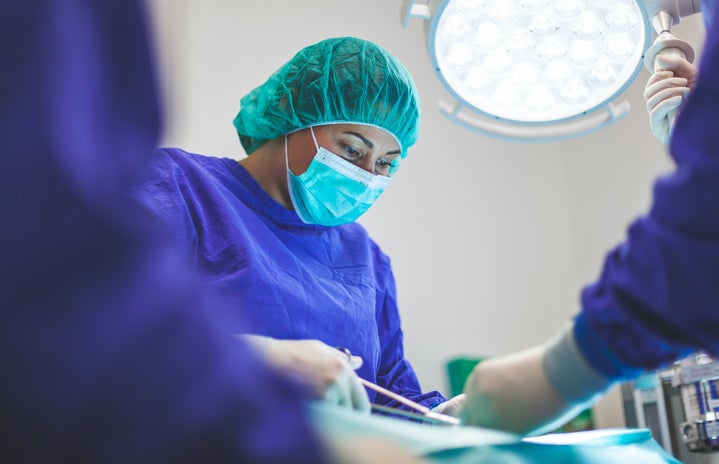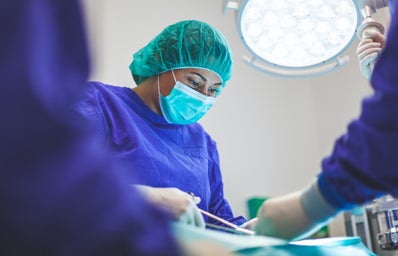Last summer, I got a nose job.
That’s an oversimplification. After a freak cheerleading accident my freshman year of high school (my teammate fell and kicked me right in the face), my nose was broken. Last summer, I underwent septo-rhinoplasty surgery to correct that.
“Septo” indicates the purpose of the surgery is to improve breathing. The accident gave me a deviated septum that caused my left nostril to be semi-blocked. The constricted airway made it difficult to breathe properly.
“Rhino” part means the surgery had a cosmetic element to it. Due to my deviated septum, my nose bridge curved left and nursed a hefty bump. The crookedness wasn’t outwardly obvious, but staring at my face long enough resulted in a lot of “It’s really not that bad!” or “I barely noticed,” from my friends. No need to lie. It was pretty bad.
When I tell people this story, I am always asked: how did it get to the point of surgery?
That’s a funny story. When you break your nose, you have up to 8 days where a doctor is able to non-surgically break it back into place. Anytime past the 8 day mark means your nose has already healed in that position. The only way to correct the break is surgery.
It took me a month to realize my nose looked a little different and my breathing issues were not imaginary. When I received the official diagnosis, I was far past the period of time where they could non-surgically correct my nose. But at 13 years old, I was way too young to receive facial surgery. I had to wait until I was 18 to get my nose fixed.
So, on June 23, 2023, five years after the accident and exactly one week after my freshman year of college, I got a brand new nose. And my nose looked amazing, I felt perfectly fine, and I lived happily ever after! Right?
If only it were that easy. In reality, I was sent home with a humongous cast and two stents up my nose. Gauze was taped under my nose to catch any excess blood. My head was throbbing and my mouth was dry. I was nauseous from the anesthesia and had trouble keeping my eyes open.
I woke up day two post-op with a disorienting amount of blood in the gauze and puffy eyes. My eyes were practically swollen shut on day three. Day four gave me puffy lip fillers, and the previously dark purple bruising turned yellow on day five. Days six and seven consisted of chipmunk cheeks and extremely dry mouth.
I went into day eight, cast removal day, ready for the nightmare to be over. However, while the past week had been physically traumatizing, the following weeks would be the most confusing and mentally draining weeks of my life.
I will admit, my expectations were too high. Yet I was so blinded by anticipation, my disappointment hit me like a truck (or, for a more relevant metaphor, hit me like a cheerleader falling on my face).
Majority of my time was spent constantly looking in the mirror. The face looking back was me, but I didn’t recognize myself.
That feeling of disorientation is difficult to put into words. I didn’t feel ugly, but I cried whenever I saw a picture of myself. My nose was technically perfect, yet the absence of crookedness only led me to discover new insecurities.
As I began to integrate myself into the real world, I was met with long observational stares from my friends. They marveled at my “quick” recovery and asked hundreds of questions. I told them the same story I wrote above, along with visual aids. The most common responses I got were “I can hardly tell you got work done” and “You never really needed surgery in the first place.”
I go back and forth on how noticeable I want my new nose to be, especially as I transition from the comfort of my home back to college life. On one hand, I want people to notice — I didn’t go through that pain for people to think I look the same!
On the other hand, I’m ashamed. I couldn’t help but imagine what other people might whisper behind my back: how vain of her to feel so insecure to the point of surgery. How incredibly spoiled of her to get a nose job. How weak of her to give into beauty standards.
The stigma surrounding cosmetic surgery is no secret. Actors, models and Kardashians don Brazilian butt lifts and liposuctions, countless injections and removals. Already-beautiful people go under the knife and emerge looking like an enhanced version of themselves.
They insist their butts grew bigger from the gym and they simply “grew into their nose.” Their lack of wrinkles is from a revolutionary Neutrogena face cream (which they conveniently sponsor). Their lips have always been that full and cheekbones always that defined. It’s all “natural.”
People are often secretive when they undergo cosmetic surgery in fear of being judged. Yet they are judged for being secretive. So is it better to be open about getting surgery, admit your insecurities to the public and deal with the judgment? Or to be accused of lying and ignore the speculation. It’s a cyclical dilemma.
I obviously picked the first route: being open. The only way to remove the stigma is to be upfront about it. Taking the steps to correct an insecurity shouldn’t be something to be ashamed of.
However, we must confront why these insecurities exist. Beauty standards are harmful and unrealistic, and should therefore be eliminated. Yet the existence of cosmetic surgery prevents that from ever happening.
I never really understood the complexity until I had to live through it myself. While the purpose of the surgery was medical, I would be lying if I didn’t acknowledge my desire for the “perfect nose.” It’s embarrassingly narcissistic, yet so indicative of modern beauty culture.
It takes an entire year to physically recover from a septo-rhinoplasty, and I’m unclear on the timeline of the emotional recovery. I’m only three months post-op. I’m not claiming to feel 100% comfortable in my new face. But all I can do is continue this journey, one (unconstricted) breath at a time.



